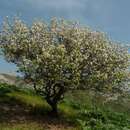pt-BR
nomes no trilho de navegação


Ayiqmurut, xirsmurut (Pyrus regelii) – ra’nodoshlar oilasiga mansub past bo‘yli daraxt. O‘rta Osiyo (Fapbiy Tyanshan, Pomir-Oloy)da tarqalgan. Toshkent, Samarqand, Surxondaryo va Qashqadaryo viloyatlarida o‘sadi. A. noqulay, suvsiz, toshloq sharoitda, quruq tog‘ yon bag‘irlarida va hatto qoyalarning yoriqlarida ham uchraydi. Aprelda gul-lab, avgustning oxiri va sentabr boshlarida pishadi. Mevasi dumaloq, qattiq, dia-metri 2–3 sm. A.ning mevasi uzilib, 10–12 kun o‘tgach, yumshab shira tortga-nidan so‘ng iste’mol qilinadi. Meva-sining qaynatmasidan tomoq og‘rig‘ini davolash va yuqumli kasalliklarning oldini olishda foydalaniladi. A.dan payvandtag sifatida, yangi nok navlari yetishtirishda, quruqtuproqli janubiy tog‘ yon bag‘irlarini o‘zlashtirishda va man-zarali o‘simlik sifatida foydalanish mumkin.
Ayiqmurut, xirsmurut (Pyrus regelii) – ra’nodoshlar oilasiga mansub past bo‘yli daraxt. O‘rta Osiyo (Fapbiy Tyanshan, Pomir-Oloy)da tarqalgan. Toshkent, Samarqand, Surxondaryo va Qashqadaryo viloyatlarida o‘sadi. A. noqulay, suvsiz, toshloq sharoitda, quruq tog‘ yon bag‘irlarida va hatto qoyalarning yoriqlarida ham uchraydi. Aprelda gul-lab, avgustning oxiri va sentabr boshlarida pishadi. Mevasi dumaloq, qattiq, dia-metri 2–3 sm. A.ning mevasi uzilib, 10–12 kun o‘tgach, yumshab shira tortga-nidan so‘ng iste’mol qilinadi. Meva-sining qaynatmasidan tomoq og‘rig‘ini davolash va yuqumli kasalliklarning oldini olishda foydalaniladi. A.dan payvandtag sifatida, yangi nok navlari yetishtirishda, quruqtuproqli janubiy tog‘ yon bag‘irlarini o‘zlashtirishda va man-zarali o‘simlik sifatida foydalanish mumkin.
Pyrus regelii is a species of wild pear in the family Rosaceae, native to Central Asia (except Uzbekistan, where it occurs but is considered introduced).[1] A small tree usually 6 m (20 ft) tall, but reaching 9 m (30 ft), its young branches are cloaked in a grey down, which provides visual interest when it is planted as an ornamental.[2] Its leaves, which are also downy when young, are exceptionally variable in shape, sometimes even on the same individual.[2] The fruit are small but typical pears, and are collected and eaten by local peoples.[3] The most xerophytic member of its genus, it is occasionally used as a rootstock for cultivated pear trees, as a garden ornamental, and for reforestation projects, all in dry areas.[2][4]
Pyrus regelii is a species of wild pear in the family Rosaceae, native to Central Asia (except Uzbekistan, where it occurs but is considered introduced). A small tree usually 6 m (20 ft) tall, but reaching 9 m (30 ft), its young branches are cloaked in a grey down, which provides visual interest when it is planted as an ornamental. Its leaves, which are also downy when young, are exceptionally variable in shape, sometimes even on the same individual. The fruit are small but typical pears, and are collected and eaten by local peoples. The most xerophytic member of its genus, it is occasionally used as a rootstock for cultivated pear trees, as a garden ornamental, and for reforestation projects, all in dry areas.